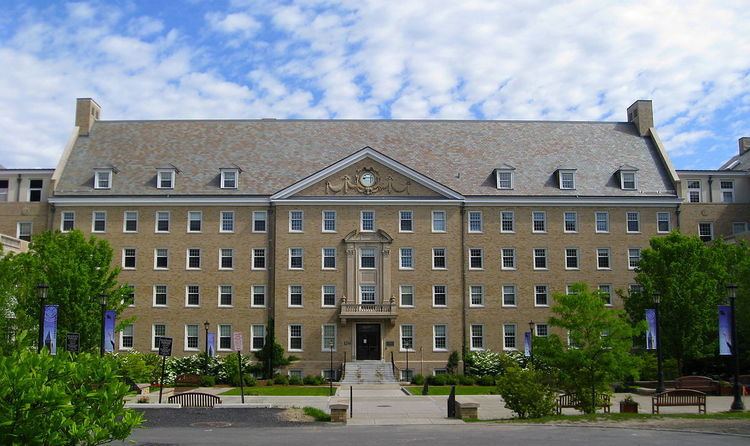Type Statutory Academic staff 105 professors Postgraduates 458 Phone +1 607-255-2247 | Established 1925 Undergraduates 1,250 Total enrollment 1,475 (2010) Dean Alan Mathios | |
 | ||
Location Ithaca, New York, U.S.A. Address Martha Van Rensselaer Hall, #170, Ithaca, NY 14850, USA Undergraduate tuition and fees Local tuition: 25,185 USD (2011), Domestic tuition: 41,325 USD (2011) Similar Cornell University, Cornell Tech, State University of New Y, Kansas State University, New York State College o Profiles | ||
The Cornell University College of Human Ecology (HumEc) is a statutory college affiliated with the State University of New York (SUNY) and a component of Cornell University in Ithaca, New York. The College of Human Ecology is a compilation of area of study, such as consumer science, nutrition, health economics, public policy, human development and textiles, each through the perspective of human ecology.
Contents
New York State residents and out-of-state residents are eligible to attend College of Human Ecology and in-state residents attending the college pay a reduced rate compared to the tuition rates for their out-of-state counterparts. In 2007-2008, the HumEc total budget of $42 million included $33 million in tuition revenue and $9 million in state appropriations.
Academics
The New York State College of Human Ecology enrolls approximately 1,250 undergraduates and 458 graduate students, and has approximately 105 professors and lecturers, and 70 research associates. Human Ecology provides a liberal arts foundation supporting career-specific preparation in a small college environment. The admitted freshman profile is in the middle 50th percentile. In 2005, the Cornell Alumni Magazine reported males represented 25 percent of College of Human Ecology 2005–06 student body.
Five academic departments comprising the New York State College of Human Ecology are Design and Environmental Analysis, Fiber Science & Apparel Design, Human Development, Policy Analysis and Management, and Nutritional Sciences, which offer the following undergraduate majors: Design and Environmental Analysis; Fiber Science and Apparel Design, with possible options in Apparel Design, Fashion Design Management, or Fiber Science; Global and Public Health Sciences; Human Biology; Health and Society; Human Development; Nutritional Sciences; and Policy Analysis and Management. Thirty-five to forty percent of Human Ecology students continue in professional or graduate degree programs following the completion of undergraduate degree programs.
History
The home economics movement emerged toward the end of the nineteenth century. Pioneers such as Ellen Swallow Richards and Mr. and Mrs. Melvil Dewey championed home economics as a field in higher education.
From 1903 to 1907 Martha Van Rensselaer, and American nutritionist Flora Rose (1874-1959), and Anna Botsford Comstock taught early home economics courses at New York State College of Agriculture. and later co-directed the fledgling department of Home Economics. In 1914, the United States Congress passed the Smith-Lever Act to establish a system of cooperative extension services provided by land-grant universities for the purpose of educating American farmers, youth, and other groups, about developments in the fields of agriculture, home economics, 4-H and other related domains. Van Rensselaer and Rose advocated for the state chartered of 1925 for the New York State College of Home Economics - the first unit of its kind in the United States. In 1929, Eleanor Roosevelt lent political influence to assist the College to obtain public funds to construct a building, later completed in 1933. In 1969, the College was renamed New York State College of Human Ecology. The term human ecology refers to methodology to sudy relationships between people and natural and constructed environments.
The New York State College of Human Ecology has remained under the management and control of the State University of New York, and the College is therefore subject to the supervision and oversight of the SUNY trustees.
Facilities
In 1933, the New York State College of Human Ecology was housed in Martha Van Rensselaer Hall (MVR), located at 116 Reservoir Avenue in Ithaca, New York. The Georgian Revival style brick building was designed by architect William Haugaard of the New York State Dormitory Authority (DASNY). The building was named after Martha Van Rensselaer (1864-1932) - pioneer in the field of home economics.
In 1968, architect Ulrich Franzen designed an addition on the north side MVR Hall. The expansion provided studio and laboratory space for faculty and students. In 2003, Dean Patsy Brannon presided over the completion of a west wing addition to MVR Hall, providing space for the Division of Nutritional Sciences, including a human metabolic research unit as well as an interactive distance-learning classroom. In 2001, MVR Hall's north wing was urgently evacuated due to structural problems, and demolished in 2005. In 2011, a new 89,000-square foot facility designed by Gruzen Samton and IBI Group was completed to provide a parking garage, a three-story building, and a commons adjacent to the existing building. In 2015, the Green Parking Council certified the parking structure a green garage.
